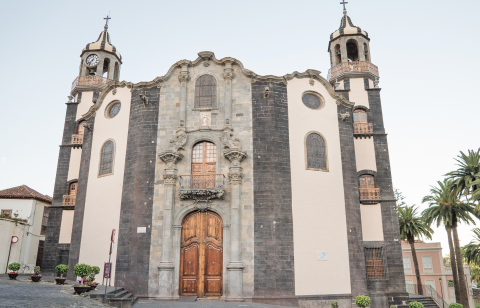
From this square, you can enjoy the best viewpoint of the church’s facade. There has been a small church here since the Conquista at the end of the 15th century. A second church was built in the 16th century on the same site. The current building, which has been granted the category of National Monument, was built in the 18th century after the Güímar earthquakes.
The façade is one of the most interesting baroque portals of the Canary Islands. Let's pause for a moment to admire the church's exterior. Note the curved façade that divides the temple's naves and the elegant stone portal. The clock and bell towers arise in the background. Together, the façade and the towers accentuate the church's verticality, projecting a sense of roundness and elevation. A sensation of movement is added with the serpentine cornice and the curve that forms the three naves. The impressive gargoyles influenced by medieval bestiaries and Native American sculptures also accentuate the sensation of movement, unease and unrest.
Let's go inside to see the dome and tambour. The dome provides the filtered light that suggests stillness and balance, in symbolic contrast to the external movement and restlessness.
Take a closer look at the details of the large baroque altarpieces of carved wood and the rich marble tabernacle from the Italian school on the main altar.
You’ll find a wealth of works of art in the Concepción Church: paintings, sculptures, textiles and goldwork. If you fancy, you can visit the "Museum of Sacred Art of La Concepción" located inside the temple.
Let's stay here for a few more moments to discover the symbols hidden within the church walls. Head over to the two central columns closest to the main altar. You’ll find embossed panels on the columns with hidden symbols. On the column on the right, you can see the Ladder of Jacob, which symbolises the rise of angels to heaven or the rise to Masonic virtue. Above it, is a triangle with a central eye representing the Luminous Delta: the symbol of God and Knowledge. On the left column, half-hidden under the marble pulpit, you can find this same figure but inverted. And on the side panel, the sun and moon flank a banana tree. The sun and moon allude to the alpha and the omega, i.e. the beginning and the end.
This symbology is common to Christianity and Freemasonry, so there is an ongoing debate about its origin. Although the Church condemned Freemasonry from its inception, being a Mason and professing the Christian faith were not incompatible. Freemasonry considers God to be the Architect of the Universe, but its beliefs in science and research created mistrust in the Church, which quickly accused it of being linked to Satanism. In the late 18th century in La Orotava, the vast majority of the members of the local Masonic lodge were practicing Catholics and some were also involved in the church's construction.
Let's now walk around the back of the church. Head up Calle Colegio to your tour's next stops. As soon as you start walking up, you can see Monteverde house on the left. Cross the street to find the next route code.





